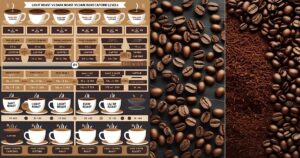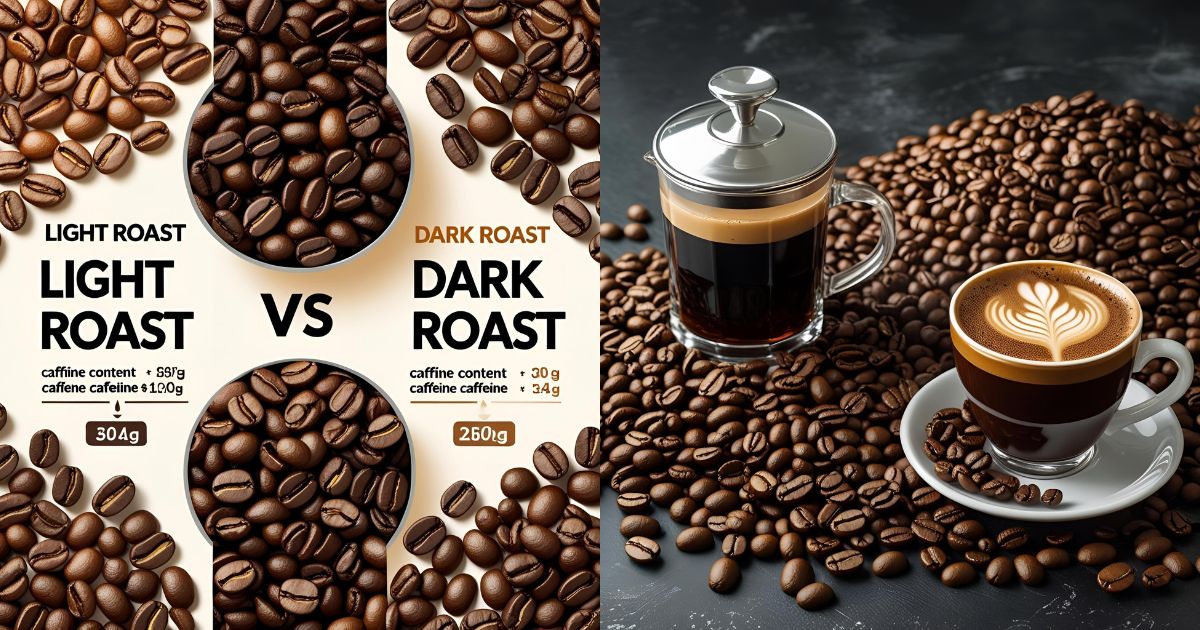Last updated on July 29th, 2025 at 08:16 pm
“Light Roast vs Dark Roast Caffeine Content” is not about dark roast packs a stronger caffeine punch.
Most coffee lovers believe that a dark roast delivers more energy.
Science reveals that the difference is minimal.
Precise measurements show that factors like bean density and brewing method play a bigger role.
This insight could change how you choose your daily cup.
Dive in to discover the truth behind the myth and how you can brew smarter for the perfect caffeine fix.
How Roasting Affects Coffee Beans
Roasting transforms coffee beans—but not the way most people think.
When it comes to caffeine content, what you see on the surface doesn’t always match what’s inside. Let’s break it down.
Why Caffeine Levels Stay Stable During Roasting
Despite common myths, caffeine doesn’t burn off during roasting.
Here’s why:
Caffeine is extremely stable — it has a high melting point (about 238°C or 460°F).
Most roasting processes never reach temperatures that can destroy caffeine.
Whether light or dark roast, caffeine remains nearly intact during the entire roast cycle.
Sources confirm this across the board:
Healthline: Roasting does not significantly affect caffeine levels.
Cooper’s Cask Coffee: Temperature doesn’t reach caffeine’s breakdown point.
Nature Journal: Caffeine structure resists heat up to commercial roast levels.
Kicking Horse Coffee & Scribblers Coffee Co.: Both roast types retain comparable caffeine content.
Wikipedia & Bellwood Coffee: The differences are due to volume and density—not roasting loss.
Bottom line? Caffeine survives the roast. The real changes happen in the structure of the bean.
Bean Transformation — Density, Moisture & Size
Roasting doesn’t reduce caffeine, but it does change everything else about the bean.
Here’s how:
Light roast beans are denser because they retain more moisture and undergo less expansion.
Dark roast beans puff up, becoming larger and more porous—but lighter in weight.
That means:
A scoop of light roast contains more mass (and slightly more caffeine) than a scoop of dark roast.
But weigh the beans, and caffeine levels are nearly identical.
Referenced by:
Cooper’s Cask Coffee: Light roasts weigh more per scoop due to density.
Healthline: Bean expansion during roasting changes caffeine per volume, not per gram.
Real Simple: Visual difference = bigger beans, but not stronger coffee.
This matters because how you measure your coffee—by weight or volume—directly affects how much caffeine ends up in your cup.
Caffeine Content by Roast Level

So how much caffeine are we actually talking about?
What the Studies Show (Percentage by Mass)
Scientific research gives us a precise comparison:
Light roast: ~1.13% caffeine by mass
Medium roast: ~1.17%
Dark roast: ~1.08%
That’s right — the differences are tiny.
Data backed by:
Real Simple: Percentages based on standardized lab tests.
Peet’s Coffee: Caffeine content stays stable through roast.
PMC Research: Minor variation due to bean structure, not roast level.
What This Means for Your Cup — Absolute vs Relative Difference
In real-world brewing:
If you use scoops (volume), light roast may deliver slightly more caffeine.
If you use a scale (weight), the roast level makes almost no difference.
Key takeaway: The myth that “light roast = more caffeine” is only true if you measure by scoop.
If you brew by weight, your caffeine hit stays consistent, no matter the roast.
Why Measurement Method Matters – Weight vs Volume
Roast level doesn’t tell the whole caffeine story—how you measure your coffee does.
This section breaks down why using scoops vs a scale can drastically change your caffeine intake.
Volume-Based Measurements (Scoops or Tablespoons)
Most people scoop their coffee.
But here’s the problem: volume doesn’t account for bean density.
Light roast beans are smaller and denser.
Dark roast beans are larger and puffier.
So, when you use a tablespoon or scoop:
A scoop of light roast packs in more mass = more beans = more caffeine.
A scoop of dark roast contains fewer beans = less caffeine.
Sources confirm it:
PMC: Volume-based brewing favors light roast for higher caffeine.
Scribblers Coffee Co.: Denser beans = more caffeine per scoop.
Wikipedia: Caffeine amount changes with density, not roast color.
Takeaway: If you measure by volume, light roast gives you more caffeine.
Read Also:
👉 How to Make Coffee with Whole Beans
👉 Teacup vs Coffee Cup Guide
Weight-Based Measurements (Using a Scale in Grams)
Weighing your coffee tells a different story.
Why?
One gram of dark roast and one gram of light roast contain the same amount of caffeine—within a few percent.
You need more dark roast beans (by count) to match the weight of light roast beans, but the total caffeine is nearly identical.
Key sources:
Wikipedia: Caffeine content is stable per gram across roast levels.
Bellwood Coffee: Scale-based brewing levels the caffeine field.
Reddit (r/Coffee): Weighing reveals roast level doesn’t matter for caffeine, only bean mass does.
Pro Tip: Brew with a digital scale if you want consistent caffeine, no matter the roast.
Real-World Example – Test Kitchen Case Study
A home barista tested this on Reddit (and it’s backed by Cooks Illustrated data):
10g of light roast and 10g of dark roast = same caffeine
1 scoop of light roast = up to 60% more caffeine than 1 scoop of dark roast
That’s a huge difference—just based on how you measured.
Real-World Implication:
Want stronger coffee?
Use a scale, not a scoop.
Don’t rely on bean color or roast level to judge strength.
Brewing, Extraction & Caffeine Yield
So you’ve got your roast. But how you brew it matters just as much—sometimes more.
Different brewing methods extract caffeine differently, and roast level can impact how efficient that process is. Let’s break it down.
How Brewing Method Influences Caffeine Extraction
Brewing isn’t one-size-fits-all.
Each method affects how much caffeine ends up in your cup:
Espresso: Fast, high-pressure, small volume. Quick extraction = less total caffeine per serving, but high concentration per ounce.
French Press: Full immersion. Longer contact = more caffeine drawn out.
Cold Brew: Long steeping (12–24 hours). Yields smooth flavor and high caffeine content—often more than hot methods.
According to CoffeeGeek, the brew method has a bigger impact on caffeine yield than roast alone.
Roast vs Porosity & Extraction Efficiency
Roast level affects the porosity of the bean, which influences how well caffeine is extracted.
Dark roasts: More porous, easier water flow—but can lead to under-extraction if rushed.
Light roasts: Denser, slower to release solubles, including caffeine.
Medium roasts: Often the sweet spot—ideal porosity and structure for efficient extraction.
What the data says:
Peet’s Coffee: Medium roast beans offer the best balance between flavor and extraction.
Berry College Study: Found medium roasts released more caffeine in standard brewing.
WIRED: Roast affects extraction rate, but grind size and time are equally crucial.
Actionable tip: Match your grind size and brew time to your roast level to maximize caffeine extraction.
Flavor & Health Context – What Else Should You Know?
Caffeine isn’t the only thing roast levels affect.
Let’s talk taste and health.
Flavor Differences: Acidity, Body, and Tasting Notes
Light roasts have higher acidity, floral or fruity notes, and a crisp finish.
Dark roasts bring out bolder, smokier, chocolatey flavors with low acidity.
Medium roasts sit in the middle—balanced, rounded, versatile.
Healthline and Bon Appétit both emphasize that roast level dramatically alters flavor, even when caffeine is nearly unchanged.
Choose your roast for taste preference, not caffeine strength.
Health Aspects – Antioxidants, Acrylamide & More
Roasting doesn’t just influence caffeine—it changes the bean’s chemistry.
Light roasts preserve more chlorogenic acids, a powerful antioxidant.
Dark roasts tend to have lower acrylamide levels, a compound formed early in roasting and reduced over time.
According to PMC studies and Healthline, the health benefits of coffee vary slightly by roast level—but not enough to make one clearly “healthier.”
Your healthiest cup depends more on brew method and additives (milk, sugar) than the roast itself.
Practical Tips – How to Choose & Measure
Use a Scale Over Scoops for Consistent Dosing
Scoop size changes. Bean size varies.
A digital scale removes all guesswork.
Always measure coffee in grams to control your caffeine dose, no matter the roast.
Choose Based on Flavor Preference, Not Caffeine
Caffeine stays consistent. Flavor doesn’t.
- Light roasts: acidic, citrusy, complex
- Medium roasts: balanced and sweet
- Dark roasts: bold, roasted, low acidity
Pick the one that tastes best to you.
Adjust Brewing and Roast to Optimize Caffeine Dose
Want more caffeine? Tweak how you brew:
Use finer grind for better extraction
Increase brew time slightly
Use immersion methods like French press or cold brew
Stick to medium roast for optimal extraction and porosity
Brewing matters more than bean color.
Conclusion – Final Takeaways
Light roast vs dark roast caffeine content isn’t as different as you’ve been told.
Caffeine content is nearly identical if measured by weight
Light roast gives more caffeine per scoop due to density
Flavor, not roast level, should guide your choice
Your brewing method can raise or lower your caffeine intake far more than the roast can
Final Tip: Use a digital scale. Choose a roast you love. Brew smart.
Let your taste—not the color of the bean—be your guide.
FAQs
Which roast has more caffeine: light or dark?
Light roast typically has more caffeine by volume because it’s denser. However, when measured by weight, caffeine levels are nearly equal.
Does roasting coffee reduce caffeine content?
No, caffeine is stable during roasting. The roasting process does not significantly decrease caffeine levels in the beans.
Why does light roast have more caffeine per scoop?
Light roast beans are denser than dark roast, so more fit in a scoop—resulting in slightly more caffeine by volume.
Is dark roast stronger than light roast?
Dark roast tastes stronger and bolder but doesn’t contain more caffeine. Strength in flavor ≠ strength in caffeine.
Should I choose coffee based on caffeine or flavor?
Choose based on flavor. Caffeine content differences are minimal, but flavor varies significantly between roasts.
How does brewing method affect caffeine extraction?
Brewing methods like cold brew and espresso extract caffeine differently. Longer brew times or finer grinds typically increase caffeine yield.
What is the caffeine content of light, medium, and dark roasts?
On average:
Light roast: ~1.13% caffeine
Medium roast: ~1.17%
Dark roast: ~1.08%
Measured by weight, these are nearly the same.

Shahriar brings a unique blend of storytelling prowess and digital expertise to Daily Coffee Guide. With a background in SEO and content strategy, he ensures our articles on Beans, Coffee, Tea, and Drinks are both engaging and discoverable. His passion for coffee culture drives him to explore and share the rich narratives behind every cup.

